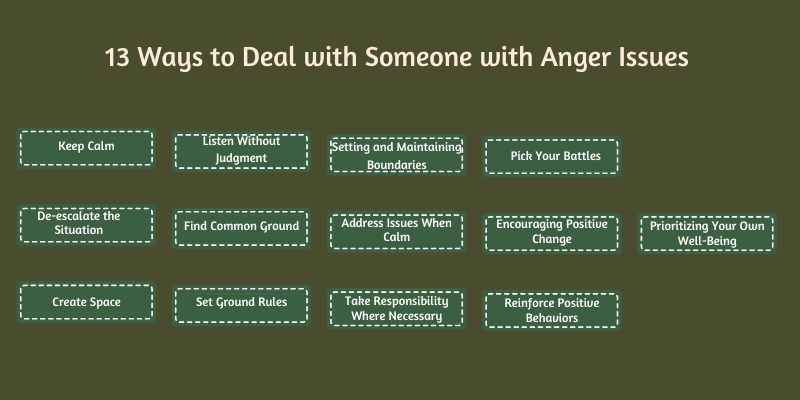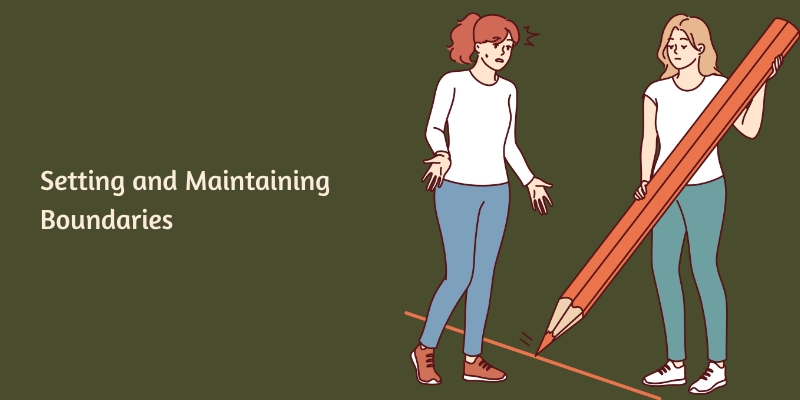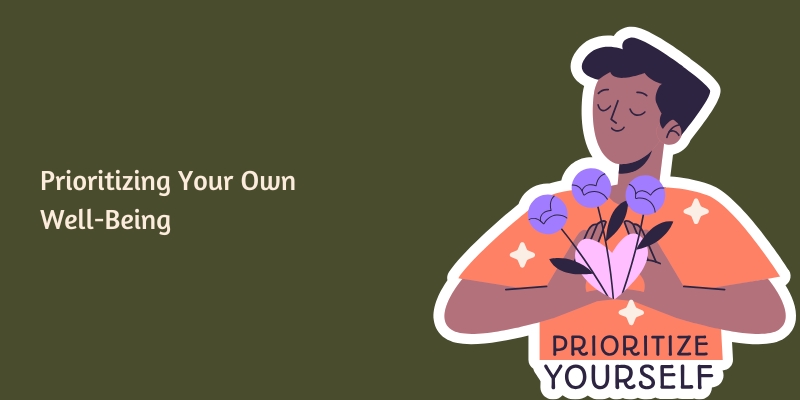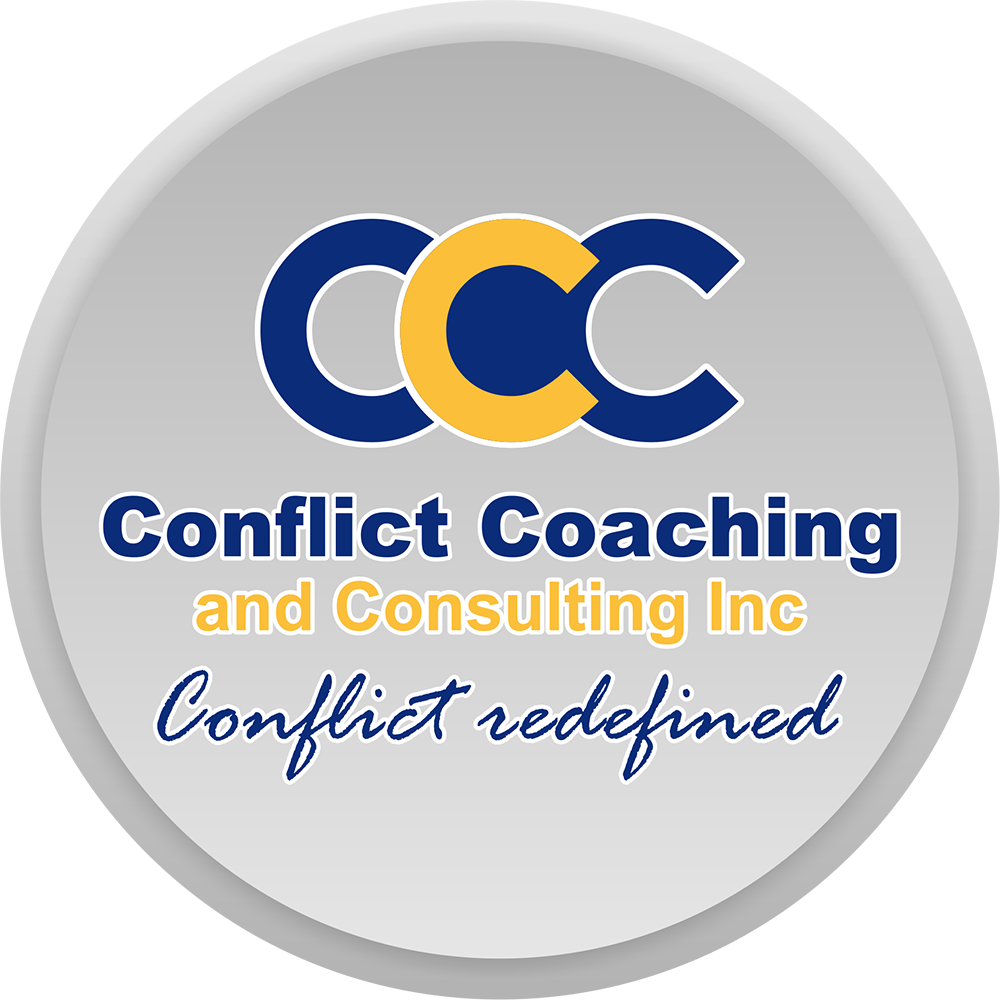
How To Help Someone with Anger Issues?
Dealing with someone who has anger issues can be stressful and emotionally draining. Their outbursts might leave you feeling anxious, frustrated, or even unsafe.
Whether it’s a partner, friend, coworker, or family member, handling their anger the right way is important!
The key is to understand how to deal with someone with anger issues.
You need to stay calm, set clear boundaries, and offer support without letting their emotions take a toll on you.
It’s not about ignoring their anger or constantly walking on eggshells. Instead, it’s about understanding where their anger comes from, knowing when to step in, and recognizing when to step back.
In this blog, you’ll learn practical ways to deal with someone who struggles with anger. We’ll discuss how to communicate effectively, when to give them space, and how to protect your mental and emotional health. You’ll also get tips on when professional help might be needed.
By understanding the roots of anger and learning the best ways to respond, you can handle tough situations with confidence while making sure you take care of yourself.
Why Some People Struggle with Anger
Anger isn’t always a bad thing. It’s a natural response to frustration, fear, or feeling threatened. But when someone has frequent angry outbursts, struggles to calm down, or reacts aggressively to small issues, it can be a sign of deeper problems.
Understanding why some people have anger issues can help you handle their reactions better while protecting your own well-being.
Anger can be triggered by any inconvenience, so finding out the exact causes is essential. Here are some of the common causes of anger issues.
- Past Unresolved Trauma: People who have experienced abuse, neglect, or major loss often struggle with anger. Their brain associates certain situations with past pain, triggering an extreme response. They may react aggressively to protect themselves, even when there’s no real danger.
- Chronic Stress: Work pressure, financial problems, and relationship struggles can cause stress to build up. Without healthy coping skills, this stress can turn into frequent irritation or explosive anger.
- Mental Health Conditions: Disorders like depression, anxiety, PTSD, or bipolar disorder can make it harder to regulate emotions. Some people with these conditions lash out when they feel overwhelmed, anxious, or hopeless.
- Substance Abuse: Alcohol and drugs lower self-control and increase aggression. A person struggling with addiction may have difficulty managing their emotions, leading to frequent angry outbursts.
- Learned Behavior: Some people grow up in households where yelling, aggression, or violence is the norm. If they never learn healthy ways to express frustration, they may rely on anger to communicate.
Not everyone with anger issues reacts the same way. Some express it outwardly, while others hold it in until it explodes. Here are some common signs:
- Frequent yelling, insults, or aggressive speech
- Physical violence or threats
- Difficulty calming down after getting upset
- Blaming others for their anger
- Getting irritated over small things
- Holding grudges or seeking revenge
- Feeling guilty or ashamed after an outburst
Recognizing these signs can help you understand the person’s struggles. It doesn’t mean you have to accept harmful behavior, but it allows you to respond in a way that keeps both of you safe. In some cases, professional help may be needed to manage anger in a healthier way.
13 Ways to Deal with Someone with Anger Issues

Handling someone with anger issues can be challenging, especially if their reactions are unpredictable or intense.
Your instinct might be to argue back, shut down, or distance yourself completely. However, reacting emotionally can make the situation worse.
Instead, the key is to stay in control of your own emotions, set clear boundaries, and approach the situation with a calm and strategic mindset.
You’re not responsible for fixing their anger, but you can choose how you respond. The goal isn’t to let them walk all over you, but rather to manage the interaction in a way that keeps both of you safe and prevents further escalation.
Below are ten important strategies to help you handle difficult situations with someone who struggles with anger.
1. Keep Calm
When someone is yelling, blaming, or acting aggressively, it’s easy to get defensive. You might feel tempted to shout back or shut them down, but this often adds fuel to the fire. Instead, staying calm can prevent the situation from escalating.
Why Staying Calm Matters
Anger thrives on reactions. If you remain composed, the other person may realize they aren’t getting the response they expected and may begin to calm down. On the other hand, if you match their intensity, the situation can spiral out of control.
How to Stay Calm
- Use a neutral tone: Avoid raising your voice, sighing, or sounding irritated. A calm tone can help defuse tension.
- Control your body language: Crossed arms, rolling your eyes, or clenching your fists can make the person feel more defensive. Instead, maintain a relaxed posture and eye contact.
- Pause before responding: Take a deep breath and think before speaking. A measured response can prevent misunderstandings.
- Don’t take it personally: Their anger may not be about you at all—it could be about stress, past trauma, or something else entirely.
If you feel your own emotions rising, step away if possible. It’s okay to remove yourself from a heated situation rather than engage in an argument that won’t be productive.
2. De-escalate the Situation

When someone is in the middle of an angry outburst, their brain is in fight-or-flight mode. They’re not thinking clearly, and trying to reason with them at that moment may not work. Instead of arguing, your focus should be on calming the situation.
Why De-escalation Works
When people are angry, they often want to feel heard and understood. If you approach them with a confrontational attitude, they may see you as an opponent rather than someone who is trying to help. A calm approach can reduce their defensiveness and help them regain control.
How to De-escalate an Angry Situation
- Acknowledge their feelings: Say things like, “I see that you’re really upset right now.” This shows them you’re listening without agreeing with their behavior.
- Avoid telling them to calm down: This often has the opposite effect. Instead, say something like, “Let’s take a breath and talk about this.”
- Use short, simple responses: When someone is angry, they might not be able to process long explanations. Keep your words direct and clear.
- Give them space if needed: Sometimes, the best way to de-escalate is to step away and allow them time to cool off.
If the person’s anger turns into threats or violence, prioritize your safety. Walk away, call for help, or set firm boundaries about what behavior you will and won’t tolerate. Your well-being is just as important as theirs.
3. Create Space
When someone is angry, emotions can run high, and their ability to think rationally decreases. In heated moments, giving them physical and emotional space can help them cool off.
Forcing a conversation or staying too close when they’re upset can make things worse. Encouraging space allows them to regain control over their emotions before things escalate further.
Why Creating Space Helps
When anger takes over, the brain goes into fight-or-flight mode. This means the person may act impulsively, saying or doing things they might regret later.
Giving them space helps break this cycle, allowing their brain to reset and process emotions more clearly.
How to Encourage Space
- Suggest a break: You can say something like, “Let’s take a few minutes to cool off and talk later.” This makes it clear that the conversation isn’t over but is being paused for the sake of clarity.
- Move to a quieter place: If the person is getting angry in a crowded or noisy setting, suggest stepping away to a calmer environment. Too much stimulation can add to frustration.
- Physically step back: If they seem tense or aggressive, increasing physical distance can help prevent a situation from escalating.
- Respect their need for time: Some people calm down quickly, while others need hours. Pressuring them to talk before they’re ready can make them feel trapped.
However, creating space doesn’t mean ignoring the issue. Once they’ve had time to cool down, you can check in and have a more productive discussion.
4. Listen Without Judgment

Angry people often feel misunderstood, unheard, or invalidated. If you dismiss their feelings or criticize them while they’re venting, they may become even more defensive.
Instead, being an active and empathetic listener can help them feel acknowledged, which may reduce their frustration.
Why Listening Helps
When someone feels truly heard, their anger may soften. Many times, anger is fueled by stress, hurt, or frustration rather than a desire to lash out.
If they sense that you’re open to understanding their point of view, they may calm down more quickly.
How to Listen Without Judgment
- Let them speak first: Avoid interrupting or rushing to offer solutions. Give them a chance to express themselves fully.
- Use neutral language: Instead of saying, “You’re overreacting,” try, “I see that this is really frustrating for you.” This validates their emotions without agreeing with their behavior.
- Show understanding through body language: Nodding, making eye contact, and maintaining an open posture can show that you’re engaged. Avoid crossing your arms or looking distracted.
- Repeat back what you hear: Saying something like, “It sounds like you’re upset because you feel ignored,” can help them feel understood and may even help them reflect on their emotions.
- Avoid blame or criticism: Saying things like, “You always do this,” can make them feel attacked and push them further into anger.
Listening doesn’t mean you have to accept harmful behavior, but it does create a space for calmer, more productive conversations. When a person feels heard, they may be more willing to address their anger in a healthier way.
5. Find Common Ground
When dealing with someone who has anger issues, arguments can easily turn into power struggles. If both sides feel like they need to “win,” the conversation can become more heated and unproductive.
Instead of focusing on who is right or wrong, shifting the focus to shared goals can help defuse tension. Finding common ground allows you to work together rather than against each other.
Why Finding Common Ground Helps
Anger often stems from frustration, feeling misunderstood, or believing that the other person doesn’t care.
By identifying shared interests or goals, you can shift the conversation from conflict to collaboration. This doesn’t mean you have to agree with everything they say, but it does mean looking for areas where you can align.
How to Find Common Ground
- Acknowledge their concerns: Let them know you understand their frustration. Saying something like, “I see that this is really important to you,” can help lower their defenses.
- Identify shared goals: If the argument is about a decision, focus on what you both want. For example, if a coworker is angry about a project deadline, remind them that you both want the project to succeed.
- Use “we” statements: Phrases like “We both want to find a solution that works” or “Let’s figure this out together” shift the tone from confrontation to teamwork.
- Compromise when possible: If there’s a way to meet in the middle, suggest it. Finding even a small area of agreement can help calm the situation.
When people feel like they are on the same side rather than in opposition, it’s easier to move forward without resentment or hostility.
6. Set Ground Rules
Dealing with someone who has anger issues doesn’t mean you have to accept aggressive or disrespectful behavior.
Setting clear boundaries and ground rules for communication can help ensure that conflicts don’t become toxic or harmful.
Why Ground Rules Matter
When emotions run high, conversations can quickly become shouting matches filled with insults or personal attacks.
Having established rules for how you will communicate can prevent these situations from spiraling out of control.
How to Set Ground Rules
- Establish boundaries early: If you know someone has anger issues, make it clear what kind of behavior you will and won’t tolerate. You can say, “I’m happy to talk, but I won’t engage if there’s yelling or name-calling.”
- Stay consistent: If someone crosses a boundary, calmly remind them of the rules. If they continue, remove yourself from the conversation until they are willing to communicate respectfully.
- Avoid engaging in shouting matches: If they start yelling, don’t match their energy. Instead, say something like, “I’ll talk to you when we can have a calm discussion.”
- Use time-outs when needed: If an argument is getting too heated, suggest taking a break and revisiting the conversation later.
- Make consequences clear: If someone repeatedly violates your boundaries, there should be consequences. This could mean limiting interactions, walking away, or even seeking professional help if needed.
Ground rules aren’t about controlling the other person but about protecting your own well-being and maintaining respectful communication.
By enforcing these rules consistently, you can help prevent situations from escalating and keep conversations more productive.
7. Setting and Maintaining Boundaries

When dealing with someone who has anger issues, setting clear boundaries is essential for protecting your emotional and physical well-being.
Without boundaries, their anger can negatively impact your life, making you feel anxious, drained, or even unsafe. Boundaries help define what behavior is acceptable and what you will not tolerate.
Why Boundaries Matter
People with anger issues may not always realize when they are crossing a line. They may assume their behavior is normal or justified, especially if they’ve never been held accountable.
By setting and maintaining boundaries, you make it clear that certain behaviors are unacceptable. This can also encourage them to work on their anger management.
How to Set and Maintain Boundaries
- Be clear and direct: Instead of hoping they’ll pick up on hints, state your boundaries plainly. For example, “I won’t continue a conversation if you start yelling.”
- Define unacceptable behavior: Make it clear what you will not tolerate, whether it’s shouting, name-calling, threats, or physical aggression.
- Have a plan for when boundaries are crossed: Decide in advance how you’ll respond if they ignore your boundaries. This might mean walking away, ending the conversation, or limiting your time around them.
- Stay consistent: If you allow bad behavior sometimes but push back at other times, they may not take your boundaries seriously. Stick to your limits every time.
- Don’t feel guilty: Setting boundaries isn’t about punishing the other person—it’s about protecting your well-being.
If someone repeatedly disrespects your boundaries despite your efforts, you may need to reevaluate your relationship with them or seek outside support.
8. Address Issues When Calm

It’s never a good idea to confront someone about their anger issues while they’re still in an emotional state.
Trying to have a serious discussion when they’re agitated can lead to defensiveness, more anger, or even a full-blown argument. Instead, waiting until both of you are calm can make the conversation more productive.
Why Timing Matters
When someone is angry, their brain is in fight-or-flight mode, making it difficult for them to think rationally.
They may say things they don’t mean or refuse to listen. Waiting until emotions settle increases the chances of a constructive conversation.
How to Address Issues When Calm
- Choose the right time: Bring up concerns when both of you are relaxed, not when tensions are high. A quiet moment at home or during a peaceful activity may be a better setting than right after an argument.
- Use “I” statements: Instead of saying, “You always overreact,” say, “I feel uncomfortable when you raise your voice.” This focuses on your feelings rather than blaming them.
- Keep your tone neutral: Avoid sounding accusatory or aggressive, as this can trigger defensiveness.
- Focus on solutions: Instead of dwelling on past outbursts, discuss ways to prevent similar situations in the future. For example, “What can we do differently next time to avoid this kind of argument?”
- Know when to walk away: If they become defensive or dismissive, don’t force the conversation. You can say, “I wanted to talk about this calmly, but we can revisit it later when we’re both ready.”
Addressing issues when calm doesn’t guarantee the person will change overnight, but it creates a better environment for honest and respectful communication.
Over time, these discussions may help them recognize their anger patterns and work toward better emotional control.
9. Take Responsibility Where Necessary
When dealing with someone who has anger issues, it’s easy to focus only on their reactions. However, in any conflict, both sides contribute in some way, even if unintentionally.
Taking responsibility for your own words and actions doesn’t mean excusing their anger—it means reflecting on whether anything you said or did may have escalated the situation. Recognizing this can help improve communication and reduce unnecessary tension.
Why Taking Responsibility Helps
Angry people often feel attacked, criticized, or misunderstood. If you acknowledge any role you may have played in a conflict, it can de-escalate the situation and show them that you’re not just blaming them.
It also helps build trust, making future conversations about their anger more productive.
How to Take Responsibility When Needed
- Reflect on your reactions: Ask yourself if you raised your voice, used harsh words, or dismissed their feelings. If so, acknowledge it.
- Apologize if necessary: A sincere apology for your own actions—“I shouldn’t have snapped at you earlier”—can lower their defenses.
- Avoid blame-shifting: Saying, “I wouldn’t have reacted that way if you hadn’t yelled,” still puts all the responsibility on them. Instead, own your part without expecting an apology in return.
- Stay mindful of triggers: If you know certain topics or behaviors provoke anger, be mindful of how you bring them up. This doesn’t mean avoiding tough conversations but rather approaching them thoughtfully.
- Maintain self-respect: Taking responsibility doesn’t mean tolerating abuse or justifying their anger. It simply means being honest about your own behavior while still expecting respect in return.
By being self-aware and accountable, you set an example of calm communication, which may encourage the other person to reflect on their own actions as well.
10. Pick Your Battles
Not every disagreement is worth turning into a major conflict. When dealing with someone who has anger issues, it’s important to decide which issues are truly important and which ones you can let go.
Constantly engaging in arguments can exhaust both of you and damage the relationship.
Why Picking Your Battles Matters
Arguing over every little thing can make interactions tense and stressful. If everything becomes a fight, the other person may feel constantly criticized, which can fuel their anger even more.
Prioritizing the bigger issues allows you to maintain a healthier, more peaceful relationship.
How to Pick Your Battles
- Ask yourself if it’s worth it: Before responding to something upsetting, take a moment to consider: Does this really matter in the long run? If not, it might be better to let it go.
- Differentiate between annoyances and serious issues: Some things are minor irritations, like a sarcastic comment or a bad mood. Others—such as verbal abuse or disrespect—need to be addressed.
- Avoid unnecessary power struggles: If an argument is becoming about proving who is right rather than solving a problem, step back.
- Focus on long-term relationship health: If the goal is to maintain a positive relationship, it may be more beneficial to stay silent on minor issues while addressing bigger concerns at the right time.
- Keep your energy for important discussions: Dealing with an angry person can be draining. Save your energy for the moments that truly matter, such as setting boundaries or discussing hurtful behaviors.
By choosing when to engage and when to step back, you reduce unnecessary stress and keep interactions more constructive. Not every disagreement needs to turn into a battle—sometimes, peace is the better choice.
11. Encouraging Positive Change

When dealing with someone who has anger issues, it’s easy to focus on the negatives—outbursts, conflicts, and emotional strain. However, encouraging them to work toward positive change is just as important.
Anger management isn’t just about suppressing anger; it’s about learning healthier ways to express emotions, handle stress, and improve relationships.
While you can’t force someone to change, you can create an environment that supports personal growth. This means offering encouragement, reinforcing good behavior, and helping them see the benefits of making a change.
Even small improvements, like responding more calmly or recognizing their triggers, deserve acknowledgment. When someone feels supported rather than criticized, they’re more likely to make long-term progress.
Support Personal Growth
Encouraging someone with anger issues to seek professional help can be life-changing. Many people struggle with anger because of past trauma, unresolved emotional pain, or mental health conditions.
Therapy, medication, or structured anger management classes can help them understand and control their emotions better.
- Suggest professional help without judgment: Some people may resist therapy due to stigma or pride. Instead of saying, “You need therapy,” try, “I think talking to a professional could really help you manage stress better.”
- Recommend specific options: Cognitive Behavioral Therapy (CBT) helps people identify and change negative thought patterns, while Dialectical Behavior Therapy (DBT) teaches emotional regulation and coping skills. Anger management classes can also provide structured guidance.
- Discuss the role of medication: If their anger is linked to anxiety, depression, or other mental health conditions, medication may help. Encouraging them to speak with a doctor can be a step toward finding balance.
Supporting their journey doesn’t mean taking responsibility for their progress. They must be willing to put in the effort, but knowing they have your support can encourage them to take that first step.
12. Reinforce Positive Behaviors
People with anger issues often hear a lot about what they’re doing wrong. While it’s important to address harmful behaviors, it’s just as important to recognize when they’re making an effort to improve. Reinforcing positive behaviors helps build momentum for change.
- Acknowledge their efforts: Even small improvements, like taking a deep breath instead of yelling, deserve recognition. Saying, “I noticed you stayed calm during that tough situation. That was really great,” can encourage them to keep practicing self-control.
- Express gratitude: If they’re working on managing their anger, let them know you appreciate it. Simple statements like, “I really appreciate that we were able to talk things through calmly,” can motivate them to continue improving.
- Encourage self-reflection: When they handle a situation well, ask, “How did that feel for you?” Helping them recognize their own progress reinforces their success.
- Avoid unrealistic expectations: Change doesn’t happen overnight, and setbacks will occur. Instead of focusing on occasional failures, highlight overall progress.
By reinforcing positive behaviors, you’re helping them see that their efforts are making a difference. This builds confidence and motivation, making it more likely that they’ll continue working on managing their anger in healthier ways.
13. Prioritizing Your Own Well-Being

When you are dealing with someone who has anger issues, it’s easy to get so focused on helping them manage their emotions that you forget about your own mental and emotional health.
But taking care of yourself is just as important. If you are constantly drained, anxious, or emotionally overwhelmed, you won’t be in a good position to support the other person or manage your own well-being.
Self-Care Strategies
Taking care of your own needs is crucial, especially when you’re dealing with someone else’s anger. Self-care isn’t just about pampering yourself—it’s about setting up practices that help you stay emotionally and physically healthy.
- Build a Support System: Surround yourself with people who can offer you emotional support. Rely on trusted friends, family members, or even support groups for comfort. Talking with others who understand what you’re going through can relieve some of the emotional burden.
- Create a Safety Plan: If a person with anger issues can become violent or aggressive, it’s important to have a plan for how to handle these situations. Know where you can go if you need to leave, who you can call for help, and how to keep yourself safe. This plan isn’t about avoiding the person, but about preparing for the worst-case scenario.
- Limit Self-Blame: Understand that you are not responsible for the other person’s anger. While it’s natural to feel guilty or like you could have done more, their anger is their responsibility. Recognize that it’s not your job to fix everything, and remind yourself that you can’t control their emotions.
By practicing these strategies, you create a stronger foundation for yourself, which allows you to support others without sacrificing your own mental health.
Learn to Disengage
At times, the best thing you can do for both yourself and the person with anger issues is to step away from the situation. Learning when to disengage is critical to maintaining your mental and emotional health.
In high-stress situations, if you continue to engage, the conversation can become more heated and unproductive, leading to further emotional strain for both of you.
- Recognize when it’s time to step back: If the conversation is escalating or if you feel like the person is becoming too angry to have a productive discussion, it’s important to step away. You don’t need to engage in every argument or try to solve everything right away.
- Give them space to process: Sometimes, the person may need time alone to calm down and reflect. By stepping back, you allow them the space to process their emotions without feeling cornered or attacked.
- Know that disengaging isn’t abandoning: Taking a step back doesn’t mean you’re giving up or avoiding the issue—it’s about giving both you and the other person time to cool off before you continue the conversation.
- Practice calmness when leaving: If you need to leave the conversation, do so calmly and respectfully. You might say, “I can’t continue this discussion right now, but I’m happy to talk later when we’re both calm.” This maintains your dignity while also acknowledging that the conversation isn’t productive at that moment.
Learning to disengage is a healthy practice that helps prevent unnecessary conflict and gives you space to take care of your own emotional needs.
Conclusion
It is challenging to understand how to deal with someone with anger issues, but with the right approach, it’s possible to manage the situation while maintaining your well-being.
Encouraging positive change, whether through therapy, anger management classes or simply reinforcing their efforts, helps them learn healthier ways to manage their emotions.
At the same time, it’s important to prioritize your own well-being by practicing self-care, setting boundaries, and recognizing when to step back to protect your mental health.
It’s crucial to remember that anger issues often stem from deeper emotional struggles. While your support is important, seeking professional help can be a game-changer for someone who’s struggling.
Therapy, anger management programs, or medication can help address the root causes of their anger and improve both their emotional regulation and overall well-being.





Responses